12 Things to Do in Busan for 4 Days and 3 Nights
Thursday, September 28, 2017
Busan (previously named Pusan), the second most populated city in Korea, is home to cultural and economic sectors of southeast region of Korea. With Busan having Korea’s busiest port and strategic location, the said city became well-known for its international trade, ship building industry, as well as tourism. Busan also hosts international conventions, film festivals, as well as sports tournaments. While many foreign tourists flock to Seoul during their first time in Korea, more and more returning tourists discover Busan for its more laidback and history-filled way of life.
Coming from the Philippines, local and international airlines now offer direct flights to Busan for faster and more convenient travel. During the long weekend last August, my family and I spent the long weekend at Busan, making it my third trip to Korea. Though a weekend trip isn’t enough to explore Busan in all its glory, you can still do plenty of things in Busan for 4 days and 3 nights. I’ve listed down 12 things for you to explore in Busan for a short getaway. Read until the last part – you’ll probably want to visit that one!
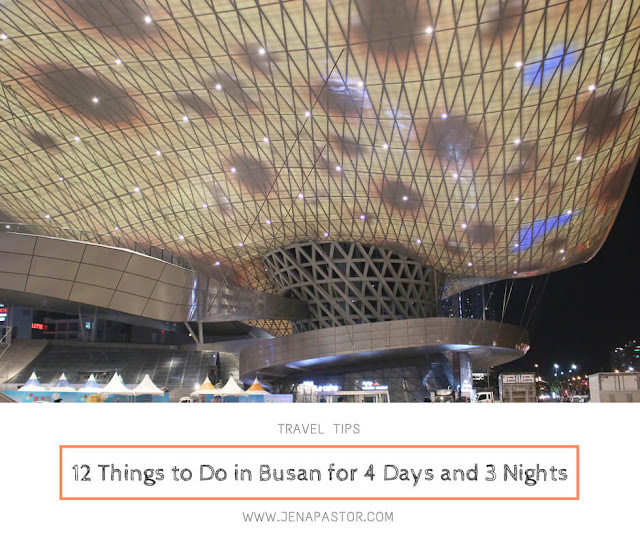 |
| Busan Cinema Center. Image from Busan Tourism Center. |
 |
| Me and my family (and the photobombers, lol) at Bay 101. Image from Busan Tourism Center. |
1. Explore Busan’s shopping districts
It’s a must to visit shopping districts in Busan, whether you’re into shopping or not. You’ll never know what you’ll need (or want) until you get there. First, check out Seomyeon area where you can find tons of shops, international brands and local boutiques. At Seomyeon subway station (metro), you’ll find plenty of underground shops selling various clothing and footwear. The underground shopping mall also has a direct link going to Lotte Department Store and along the way you’ll find the most popular Korean cosmetic and skincare brands. Stores such as Olive Young, Club Clio, Nature Republic, Etude House, Tony Moly, Nature Republic, Innisfree, Skinfood, and a lot more are very close to each other, that if you want to stock up on your favorite Korean makeup or skincare, you can easily hop from one store to another.
| Seomyeon underground shopping center. Image from Korea Tourism Organization. |
 |
| One year supply of Korean makeup and skincare from Innisfree, Banila Co, Etude House, Club Clio, and Nature Republic. |
I wasn’t able to take photos at Seomyeon underground shopping mall and Lotte Department Store because my hands were literally full of shopping bags. While purchasing cosmetics from these well-known Korean brands, I noticed that they gave more samples and freebies here than in Myeongdong, Seoul. Lotte Department Store in Seomyeon has a duty free shop (Lotte DFS) on the 8th floor where you can buy tax-free products from international luxury brands. For instance, a Louis Vuitton zippy coin purse at the ground floor of Lotte Department Store is priced at US$410, but only costs US$380 at the duty free shop. Same as in Seoul, you can only claim your duty free products at the airport when you leave (that’s at Gimhae International Airport when you purchase duty free goods in Busan).
| Lotte Duty Free Busan store at the 8th Floor of Lotte Department Store in Busan. Image from Korea Tourism Organization. |
 |
| Huge stores like New Balance, Adidas, and Aritaum can be found at Nampo shopping street. Image from peonykiss.com. |
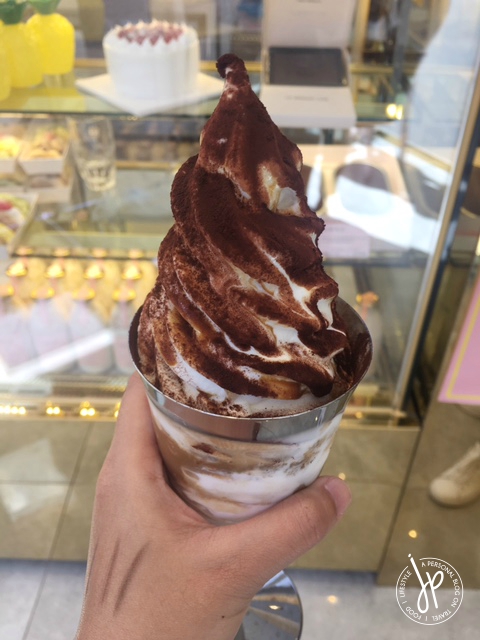 |
| Looooove this Tiramisu ice cream and this posh plastic goblet! (Excuse my brow pencil swatches, lol.) |
 |
| Sundae cone from Le Bread Lab |
 |
| Typical Korean lunch with tons of side dishes. Best Bulgogi EVER. It's a restaurant at Gwangbok-dong area very near Le Bread Lab at Gwangbok-ro 67beon-gil (left side of the road). |
2. Visit BIFF Square
A few steps away from the main shopping street of Nampo-dong, you will find BIFF Square or Busan International Film Festival Square. Similar to Hollywood Walk of Fame in L.A. or the Avenue of Stars in Hong Kong, you get to see hand prints of filmmakers, directors, and actors at BIFF Square.
 |
| BIFF Square |
 |
| Hand print at BIFF Square. Busan was previously called Pusan. |
The long street is divided into “Star Street” and “Festival Street”. Hand-printing of famous celebrities in Korea and all over the globe happens at BIFF Square during the opening ceremony of the film festival. You’ll also find theaters such as Lotte Cinema, Megabox, and CGV. In addition, souvenir stalls, leisure shops, and food stalls can be found at the square.
3. Buy food and drinks at GS25 and local supermarket
If you’re on a budget or if you want to get a quick meal, it’s best to get them all at GS25, the most popular convenience store in South Korea. I find more food choices and better tasting meals at GS25 than 7-Eleven. My favorite is Spam triangle kimbap which only costs less than KRW 2,000 if I remember correctly. Other things we bought at GS25 are the infamous banana milk, soju, ramen, and Youus taro milk tea in the purple bottle, which is a GS Retail product. I wish I had picked up the strawberry banana Youus drink as well because the taro one was very tasty.
 |
| GS25 convenience store. Image from koreabridge.net. |
 |
| I love this Youus Taro Milk Tea! |
 | |
| Late dinner on our first night in Busan. Everything is from GS25. Sandwich, banana milk, taro milk tea, soju, gatorade, triangle kimbap, and sweet potato salad. |
 |
| This honey chili flavored Doritos my husband requested me to bring home. Bought this one at a 24-hour supermarket. Some GS25 stores sell this Doritos variety. |
If you like Korean food and would like to make some at home, drop by the supermarket for authentic Korean ingredients. I bought red pepper powder, radish kimchi, pickled radish for kimbap, and spicy tofu stew mix for Haemul Sundubu Jjigae. Since I don’t live near a Korean supermarket in the Philippines, I bought some ingredients good for at least 6 meal preps.
 |
| Ingredients for Korean cuisine: pickled radish and ginseng for kimbap, and radish kimchi. |
 |
| Haemul Sundubu Jjigae mix and red pepper powder (gochugaru) for kimchi and other traditional Korean dishes. |
4. Find local fresh produce at Bujeon market
Staying at ibis Ambassador Busan City Centre allowed us to walk around Bujeon market, which is a few steps away from the hotel. You’ll find a wide variety of products in the market such as fresh fish, seafood, nuts, ginseng, dried vegetables, souvenirs, even kimchi and other side dishes common in Korean cuisine. Bujeon market is easy to spot as soon as you exit Bujeon station (opposite side of Exit 1).
 |
| Root crops for sale |
 |
| Bottle gourd (upo) and bitter gourd (ampalaya). They sell dried bitter gourd, too. |
 |
| Ginseng at Bujeon market |
 |
| Kimchi and other side dishes for sale at Bujeon market |
Near our hotel are sidewalk vendors who also sell plants, dried fish, seaweed, root crops, and the freshest fruits and vegetables at cheap prices. If you plan on having fruits for the entire duration of your stay (and you should for good health), I suggest you buy them from local sellers than in supermarkets. I bought fresh peaches for only KRW 5,000 (about Php 225) and I get 10 pieces. It was the first time I ate fresh peaches and they taste really good. Btw, if you happen to see a very old lady selling fruits at Bujeon station at night, buy some before you exit the station so she can go home early. Say a prayer for her, too.
 |
Fresh and affordable fruits at Bujeon sidewalk
5. Have a feast at Bupyeong Kkangtong Night Market
You know a tourist destination is worth-visiting if it has a landmark showcasing affordable and sumptuous food for all ages. Bupyeong Kkangtong Night Market opened its stalls on October 29, 2013 and since then both locals and tourists flock to the market and have a taste of Korean cuisine as well as international flavors all in one spot.
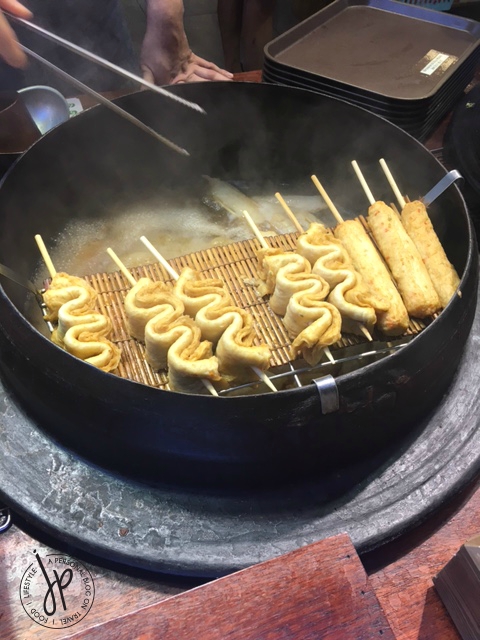 |
| Yummy Busan fishcake! |
From Japanese food to Southeast Asian dishes such as Filipino and Vietnamese cuisine, food lovers take time in lining up at booths and stalls. Aside from food, visitors can also grab some drinks made with fresh fruit juices and other mixes bottled in quirky containers.
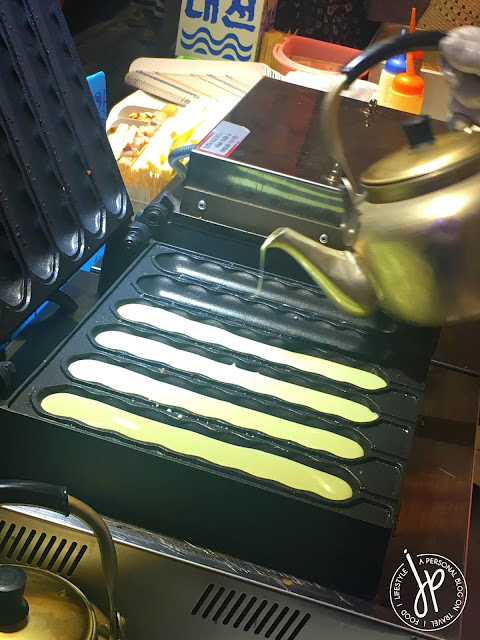 |
| Waffle-takoyaki fusion |
We began walking towards Bupyeong Kkangtong Night Market at around 7:30pm. Stretched at 110 meters, you will find around 30 mobile stalls at the night market’s alley. It was difficult to decide which one to eat first because everything was so delectable! You just have to be patient and line up on these booths to get a taste. It becomes quite crowded (especially on weekends) due to the narrow space, but the night market has an organized system pertaining to the direction of people walking down the alley.
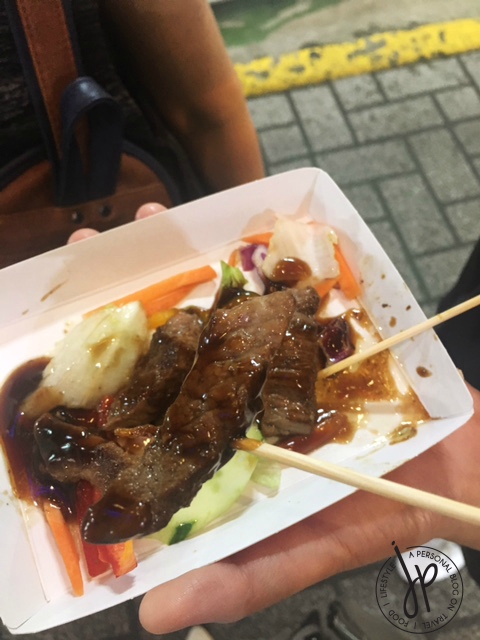 |
| I like my steak well done, but this medium rare steak is mouth watering! |
I suggest coming here on a nearly empty stomach so you can taste as much food as you can. Mobile carts don’t have seats so you have to eat standing up. However, some stalls on the side offer limited tables and chairs where you can sit. Spending two hours here is enough to fill your belly, but you can spend the entire night at the market until 12:00 midnight.
After eating, there are designated trash bins at the end of every alley. If you prefer Korean barbecue and a bottle of soju, you can go outside the night market. You’ll find small restaurants in streets offering samgyeopsal.
6. Marvel at Busan Cinema Center’s structure
K-drama fans unite! Busan Cinema Center is the official venue for the Busan International Film Festival held annually for two weeks either in September, October, or November. During the said film festival, more or less 300 films from different countries are shown. Walking around this massive area of film genius takes you closer to your favorite Hallyu stars. Just imagine following their steps on the red carpet!
 |
| Busan Cinema Center. Image from Busan Tourism Center. |
 |
| Guinness World Record for the longest cantilever roof with around 42,000 LED lights. Image from Busan Tourism Center. |
Whether you come here by day or night, the most striking feature you’ll see is Busan Cinema Center’s massive and artistic cantilever roof. If you come here at night, you’ll find a colorful dance of lights at the ceiling brought to you by 42,000 LED lights. Our tour guide said that you can ask the cinema center to make a custom lights show and message for free (hint: proposal venue).
Now for film lovers, Busan Cinema Center has an outdoor cinema with a capacity of 4,000 seats. Monthly themed movies are shown for free every Wednesday. This year, the 2017 Free Outdoor Movie Screenings at Busan Cinema Center was held from May to September. Too bad we weren’t able to experience this so make sure to check the screening schedule.
Busan Cinema Center is located very close to Shinsegae Centum City, the largest department store in the world.
7. Wander the streets of Gamcheon Culture Village
Dubbed as the “Machu Picchu of Busan” or “Santorini of Busan”, the colorful and artsy Gamcheon Culture Village was once a slum area filled with refugees during the Korean War in the 1950s. Through government funding, artists, and residents working together, Gamcheon Culture Village was rebuilt with murals, colorful pastel houses, and sculptures.
 |
| Flower shoes made of paper |
 |
| Fish mural. Image from Busan Tourism Center. |
 |
| View of Gamcheon Culture Village from the Sky Garden |
You’ll find the best view of Gamcheon Culture Village at the Sky Garden. The village itself is built on the foothills so you have to take a lot of stairs in order to snake your way in. Remember to wear comfortable shoes and bring a bottle of water when walking around.
8. Relax at Songdo beach and unwind at Songdo Skywalk
The coastal city of Busan is known for its beaches. Whether you find yourself swimming at the beach during the summer or you just simply want to chill and walk around and marvel at the sea, Songdo beach is a must-visit destination for couples and family with children.
 |
| Songdo area |
 |
| At Songdo skywalk with family. Image from Busan Tourism Center. |
 |
| My mother doing her Titanic pose at Songdo Beach |
It can get crowded during weekends, but it’s a pleasure to take time and walk along the 365-meter Songdo Skywalk above the ocean. Admission is free here so you can take as much time as you can. The place is also safe for solo travelers. It can get hot and humid during the summer months (perfect if you’re off to swim), so spend your time at the skywalk during spring or fall.
9. Make your way to Jagalchi Fish Market and Yeongdodaegyo Bridge
It might seem strange to visit a wet market as part of your trip, but the Jagalchi Fish Market is a historical landmark in Korea. Hailed as Korea’s biggest seafood market, Jagalchi began during the Korean War. Because it’s situated beside Nampo Port, you’ll get to buy the freshest seafood in Busan. In addition, you’ll get a glimpse of the daily lives of Busan citizens in the area.
Jagalchi fish market is divided into outdoor and indoor markets. You’ll find fresh and dried fish, massive octopus, and other kitchen utensils in the outdoor market. It was my first time to see a huge octopus in real life at the market – its head slightly bigger than a human’s.
 |
| Ajumma selling dried fish at Jagalchi outdoor fish market |
 |
| Various sea creatures kept fresh at Jagalchi indoor fish market |
The indoor market is a pleasure to see, for you will discover how clean Busan’s indoor wet market is as compared to traditional wet markets in some countries (like in my homeland). You’ll find clams, sea squirts, and other sea creatures that may not be available in your country. You can buy fish and seafood here, and have them cooked at restaurants outside or within the indoor market building.
Just a short walking distance from Jagalchi fish market is Yeongdodaegyo Bridge, which connects Jung-gu and Yeongdo-gu districts of Busan (mainland to island). Part of Yeongdodaegyo Bridge lifts to let ships pass for about seven times daily. However today, the bridge only lifts once at 2:00pm everyday as a historical landmark and tourist attraction.
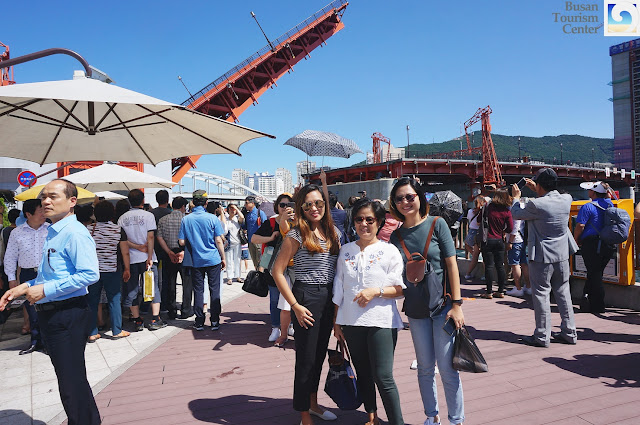 |
| At Yeongdodaegyo Bridge |
Up until today, Yeongdodaegyo Bridge is still one of the popular meeting points in Busan. It dates back during the Korean War when refugees flee to Busan and wait upon this bridge to see if their loved ones were able to escape. For tourists, the attraction seems to be entertaining because upbeat songs are being played while the bridge lifts and goes back down again for 15 minutes. For Busan citizens, however, the bridge signifies a nostalgic feeling to when they are rebuilding their lives again after the war.
10. Climb the steps going to Busan Tower
Climb the stairs (or escalator) or drive to Busan Tower to see a panoramic view of Busan from 69 meters above sea level. Similar to visiting towers in Southeast Asia, getting to the deck requires you to buy a ticket. We went here during the day and we’re able to see the busy port area and the commercial district. Couples will definitely enjoy a romantic sunset or night view of Busan from the observatory.
 |
| Entrance to Busan Tower |
 |
| View of the port from Busan Tower |
 |
| Postcard sent to the Philippines from Busan Tower. You can buy postcards ranging from KRW 1,000 to 3,500. The stamp only costs KRW 500. Just write and send your postcard at the mailbox provided in Busan Tower. |
Small trinkets and souvenirs are available at Busan Tower. I actually sent my husband a postcard from Busan Tower to our home address and we got the postcard in our mailbox exactly a month after. The experience of getting one is exciting and memorable because nowadays, it’s very seldom that you get a letter or a message via snail mail that’s not related to monthly bills (lol!). I could tell my husband was very surprised and delighted, knowing I thought about him while I was away.
Outside Busan Tower is Yongdusan Park where you can rest and relax after a day of walking. My mother and sister waited for me at this park after they went shopping at Nampo area and while I was searching for the real Namil Villa.
Some cool stuff to see before you exit Busan Tower:




 |
| My mother and our tour guide Beth from Busan Tourism Center |
11. Take a short detour to Korea’s history at the UN Memorial Cemetery
It wasn’t part of the original plan, but we ended up visiting the United Nations Memorial Cemetery. I usually don’t pick tours that include war memorials, but I’m glad we were able to visit and pay respect to fallen soldiers.

 |
| United Nations Forces and fallen soldiers listed by country |
 |
| Each country had their own piece of land where their soldiers are laid to rest. The lot reserved for the Philippines and the United States didn't have headstones, for the soldiers were brought back to their motherland. |
The UN Memorial Cemetery pays tribute to soldiers from 16 different countries who gave their lives in the battlefield during the three-year Korean War (June 25, 1950 to July 27, 1953). The war was between South Korea and North Korea, wherein each were principally supported by the United States, and China with then Soviet Union, respectively. We all know the horrific aftermath of wars: people flee from their homes, lose their livelihood, lose their lives and their family.
The UN Memorial Cemetery in Busan gives a very solemn and peaceful atmosphere as if you were in a clean and quiet park. Near the entrance is a hall that shows a 10-minute video clip, encapsulating the Korean War, the fallen soldiers, the veterans, and the memorial grounds itself. It’s hard not to get emotional during the short video because you will notice how the surviving veterans still pay respect to their comrades buried in Busan even after so many years and despite living on the other side of the world.
After the war, it became mandatory for all Korean males to serve in the military for two years.
12. Find K-drama filming locations
For K-drama fans, finding filming locations of your favorite Korean drama TV series and movies is a must when you’re in Busan. As featured on my previous blog post, on my last day I went to check out the true-to-life Namil Villa from the series Fight for My Way.
During our second day in Busan, we walked around Bujeon area where our hotel was located. At the end of the road is Bujeon Station where trains connect Bujeon to other provinces and to Seoul. KTX trains make a stop at this station as well. This particular station (Korail) is different from the metro or subway station, but happens to have the same name.
 |
| Bujeon Station (Korail) |
We thought it was another exit for the Bujeon metro but as we ascend the escalator, we noticed something that’s too similar with this particular station.
Could this be one of the filming locations of the worldwide, blockbuster zombie action movie Train to Busan?

 |
| Train to Busan clip during the zombie attack at Daejeon. Image from johornow.com. |
We went back to the hotel and looked for some information on the web, but I only found one from Yonhap News Agency. According to the news portal, “The movie [Train to Busan] directed by the acclaimed animator Yeon Sang-ho depicts a group of passengers battling against an attack by people infected with a mysterious virus on a Busan-bound bullet train, which is no longer safe from the nationwide viral outbreak. More than 50 percent of its filming was done in the city, specifically at the Busan Cinema Studios, Bujeon Station and the city-run train depot.”
While the movie was filmed in actual locations and studios, CGI (computer-generated imagery) was already added in the movie. If you recall the movie Train to Busan during the zombie attack at Daejeon, you’ll find similarities in these photos at Bujeon Station.
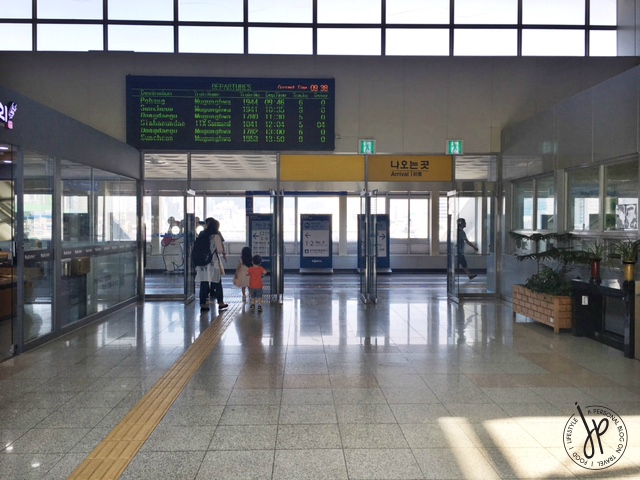


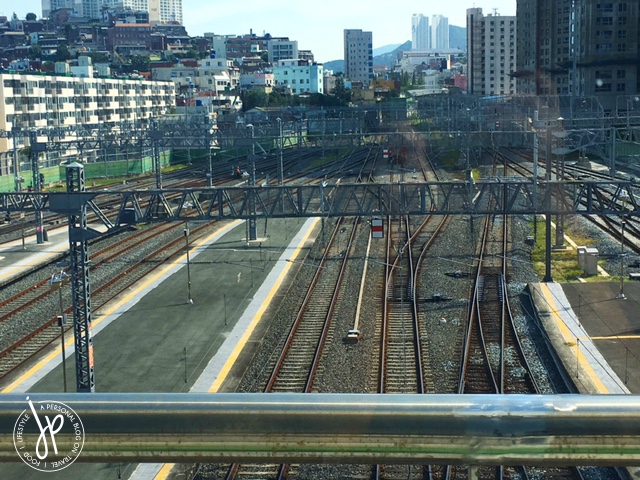
5 Tips when Traveling around Busan
1. Make sure you always have a water bottle with you. Not only will you have to endure long walks, but you will also find yourself climbing stairs.
2. All these locations are accessible by the metro. It’s less expensive to take the subway, but costs more time and energy going around Busan. If you need a travel company (especially if you’re traveling with infants, pregnant women, and the elderly), I suggest you book your tours with Busan Tourism Center like we did. The added comfort during the tours and knowledge about the landmarks make you appreciate the place and the people of Busan even more.
3. Get some of your money changed at the airport. Though you’ll get better conversion rates in the city, it’s difficult to find currency exchange locations, especially during the weekends.
4. If you see something you like at Lotte DFS, purchase it and don’t think twice! Plenty of tourists come by everyday and the stores only have limited stocks of items. Believe me, I learned my lesson.
5. Bring extra zip lock or re-sealable storage bags to keep food odor away from your belongings. You will need them in case you’re bringing home packaged products such as kimchi and pickled radish in your check-in luggage.
Hop on a plane to Busan and you’ll find another place worth visiting in South Korea, not only because of its rich history, but also because of the warm people you’ll meet along the way.





0 comments